Leica M11 First Impressions: It Might Truly Be Your Major Digicam

Leica has lastly formally revealed the M11 Rangefinder, letting us lastly put all of the rumors of what we could or could not anticipate to relaxation. Now that it’s right here, what has 5 years of improvement given us?
Leica’s latest version to its legendary M line of cameras, which started with the Leica M3 sixty-eight years in the past in 1954, has been introduced: the Leica M11. It’s the successor to the Leica M10, which was launched nearly precisely 5 years in the past at a worth of $6,495.
The Leica M11 has been hotly anticipated, with rumors swirling about its specs: will it have a hybrid OVF/EVF? Will it solely use a touchscreen and no buttons? Will Leica eliminate the baseplate? Let’s dig into it.
Editor’s observe: The next is an prolonged hands-on preview of the Leica M11, however shouldn’t be thought of a full evaluate. The digicam PetaPixel was offered for analysis was pre-production and firmware was not remaining.
Particular due to Lensrentals for offering a few of the lenses used in the course of the M11 analysis. A full record of obtainable gear each for rental and on the market could be perused Lensrentals.com.
What’s New with the Leica M11?
![]()
Let’s get the headline specs out of the best way. The Leica M11 contains a full-frame AA-less 60.3-megapixel BSI CMOS sensor with a base 64 ISO and twin achieve, a newly developed UV/IR reduce filter and RGGB shade filter array, MAESTRO III processing engine, a a lot bigger 1800mAh battery behind which rests a UHS-II SD card slot, 64GB of inner flash storage, pixel-binned 36.5MP and 18.4MP output choices, a USB 3.1 Kind-C port for charging and knowledge switch, and a brand new 3.68 megapixel* tilting Visoflex 2 EVF, which can be appropriate with the Leica M10 (and presumably M10-P, M10-R, and M10 Monochrom) in a firmware replace. The two.95” Lively Matrix TFT LCD panel — with Gorilla Glass cowl and a pair of.33 million dots — is now touchscreen succesful just like the M10-P.
*I believe this must be 3.68 million dots and never megapixels, however I’m going off the press documentation.
The combination of 64GB of inner flash storage is a really sensible transfer and one which makes plenty of sense. I believe when it comes to the internals and its restricted house, it’s simpler to combine flash storage — which could be situated anyplace inside the physique — reasonably than squeezing a second card slot subsequent to the primary slot. It additionally has further benefits, primarily that you’re by no means with out the flexibility to take photographs since you forgot, misplaced, or broken your SD card(s). I believe that switch speeds from the inner storage are additionally sooner and probably the buffer dumping, although I’ve no numbers on this.
Lastly, the worth: a whopping $8,995. This represents a 38% improve over the M10’s introductory worth of $6,495 — or $7,365 with inflation. That’s a steep worth bump, particularly for the bottom mannequin, even contemplating Leica’s historical past of worth will increase that outpace inflation (the other conduct of each different digicam producer).
The Leica M11 Physique and Menu
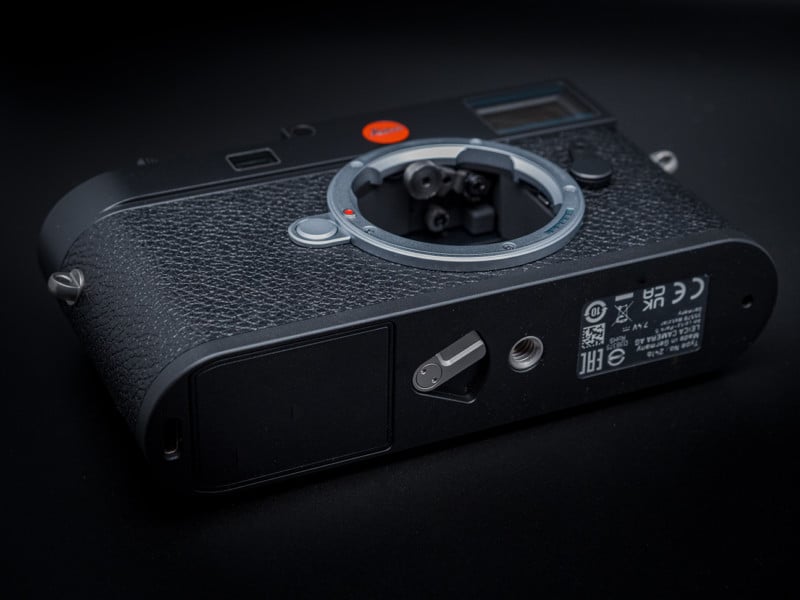
The largest exterior change within the M11 is on the underside — gone (lastly) is the antiquated base plate because the digicam inherits the identical battery design from the SL, Q, and S2/S3 our bodies. It’s simply certainly one of my favourite factors of design on any digicam and extremely fluid in use: flip the lever to partially eject the battery then push a second time to completely unlock and take away it.
Due to this we now 1) have a considerably higher-capacity battery, 2) have straightforward and fast entry to the SD card slot, 3) now not have to take away the digicam from a tripod to vary batteries or card, 4) have much-improved weather-sealing, and 5) don’t have a base plate to fret about damaging or shedding.
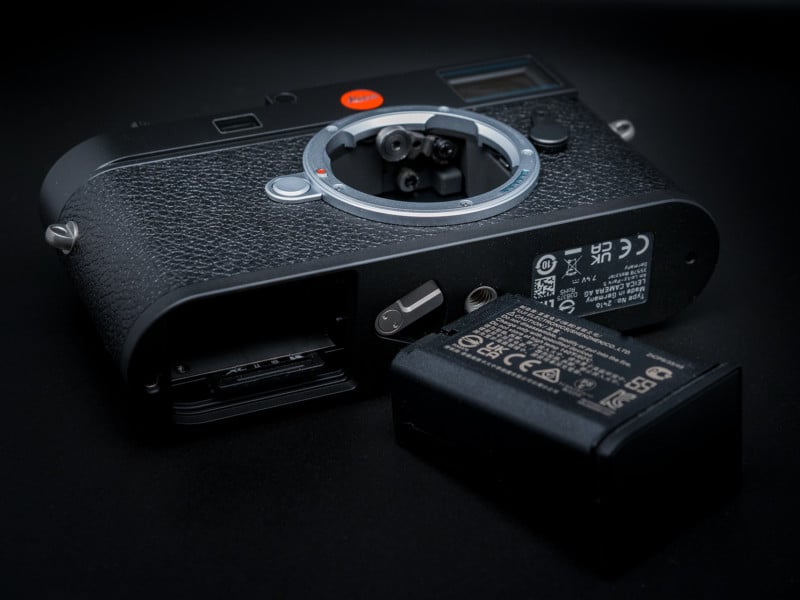
Two physique choices at the moment are obtainable: an anodized black aluminum prime plate model with a scratch-resistant coating (455 grams wihout the battery) and a traditional chrome brass prime plate model (565 grams with out the battery) — each use a magnesium housing.
The 110-gram weight distinction makes the black aluminum possibility about 20% lighter than the chrome brass. I used to be given the black aluminum model, however I used to be capable of evaluate it towards the silver brass as nicely and the distinction is actually noticeable. It’s an fascinating option to make the black variant aluminum and the silver chrome brass reasonably than the opposite method round since I really feel like folks have a tendency to love brassed black extra — maybe it’s as a result of silver chrome bonds higher to brass. Nonetheless, I believe the 2 choices are a superb transfer — I will surely get the lighter weight black — although it’s positive to anger some Leica purists.
Just like the M10, the M11 retains the identical ISO dial on the left prime facet. It’s a cool design on paper — it properly mimics the outdated rewind knob of the unique M3 and successor M2 — however not fairly as fluid in apply: it’s only a bit too stiff and recessed sufficient which you can’t get a great grip to simply and rapidly pop it up. I believe if it had much less resistance, sufficient that you possibly can pop it up along with your thumb, it could work way more fluidly. For me, it isn’t an enormous deal. I’m both at ISO 64 or in “A” mode 99% of the time, however absolutely handbook shooters could not find it irresistible. However, when you didn’t discover it a difficulty on the M10, you gained’t discover it to be one right here both.
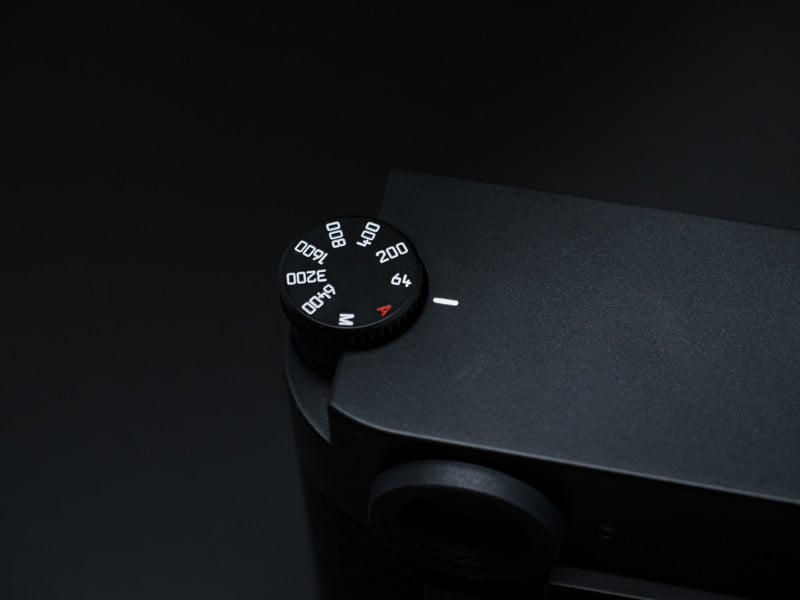
The viewfinder stays the identical: 0.73x magnification with framelines for 28/90mm, 35/135mm, and 50/75mm lenses. It’s on par with one of the best Leica viewfinders because the M3, so it stands to cause that if it ain’t broke, why repair it?
The rear of the digicam stays largely in step with the M10, with three buttons (Play, Fn, Menu) to the left of the display screen, a four-way directional pad to the proper, and a clickable command dial that defaults to publicity compensation (after a press, which I disabled) above that. By default, the Fn button cycles the rear LCD on and off — principally, out and in of live-view relying on the way you take a look at it, although both method the sensor is all the time lively with the intention to meter.
Dwell view is electronically stabilized, which does make a noticeable distinction for smoother framing and focusing — the latter is extremely easy with the digicam’s focus peaking and/or computerized magnification. Be aware that it’s only the stay view feed that’s stabilized, not the precise pictures; you may’t electronically stabilize a single photograph like you may video, in spite of everything.
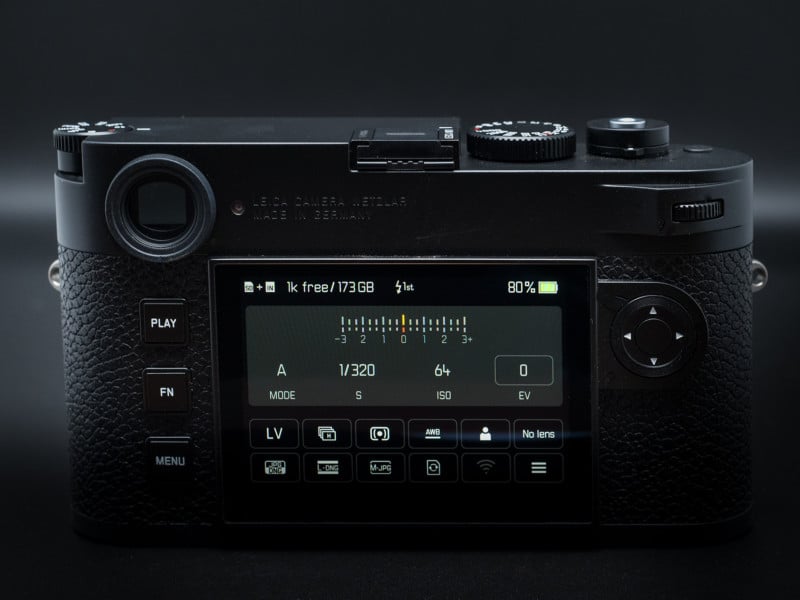
Urgent the Menu button as soon as will first carry you to a customizable Fast Entry* menu at backside of the display screen and the realm above it exhibits your fundamental capturing settings — above that could be a standing bar along with your storage, flash, and battery data (which drops in 5% increments). The Fast Entry menu means that you can regulate essentially the most generally accessed settings with out intensive menu diving and is touch-capable, although sadly, the first menu — accessed by urgent the Menu button a second time — is just not. I discovered the best method to make use of the Fast Entry menu is to faucet the perform you want, then use the rear command dial to regulate the setting — however you are able to do all of it on the touchscreen when you so select.
*Leica has not but offered me with a handbook, so some phrases could differ from the names Leica formally refers to them.
The first menu format is now in step with the SL2 and Q2, however it’s not altogether extremely completely different from the M10. Like most Leica menus, it’s fairly intuitive and simple to make use of. When you set the digicam as much as style you’ll hardly ever end up needing to entry the total menu choices.
![]()
The touchscreen is most helpful in playback: double-tapping a captured picture will zoom into that time (you can even use a pinch gesture) and dragging your finger will scan throughout the picture. One other double-tap will zoom again out and you’ll rapidly swipe left or proper to flip by pictures. The double-tap-to-magnify perform additionally works in live-view to set the magnification level for focusing.
The highest of the digicam stays nearly the identical with one exception: a brand new unlabeled button within the far proper nook close to the shutter launch that acts as a customizable perform button; I set mine to toggle the metering mode. Sadly, the M11 has misplaced the M10’s customized button on the entrance of the digicam, so we haven’t actually gained something. I’ll say although, if we will solely have one button, the brand new positioning is certainly superior and easier to entry in apply.
I might have preferred that entrance button to cycle by the 1.3x and 1.8x crop modes (39.2MP and 18.2MP), although. Talking of the crop modes, I didn’t get an opportunity to check them out in my temporary time with the digicam, so I have no idea if the M11 completely crops the picture (like Nikon) or just tags the crop and permits it to be adjusted in put up (like Canon and Sony).
There’s additionally a newly designed handgrip that doubles as a tripod bracket with its built-in Arca Swiss plate. The brand new grip can be designed to permit on the spot entry to the battery and subsequently the SD card slot, in addition to the USB-C port, with out removing of the handgrip.
Larger Battery
The brand new 1800 mAh battery — up from M10’s 1100 mAh and the identical capability because the M240 battery — offers about 63.6% extra capability in comparison with its predecessor. Given the 210 shot CIPA battery score of the M10, I anticipated an honest, however not large, improve in battery life.
As an alternative, I used to be shocked. No matter Leica has performed right here when it comes to energy effectivity, a lot of it doubtless owing to the brand new MAESTRO III processor, is nothing wanting unbelievable.
The M11 is CIPA rated for about 700 pictures (in live-view) and rated for about 1,700 in “Leica Tailored Capturing Model” (utilizing the rangefinder). I firmly belief each figures at a minimal. Within the time I had the digicam, I solely charged the battery as soon as, and it’s fairly attainable I could not have wanted to do this. Provided that I used to be utilizing a brand new digicam, I did way more chimping and menu diving than regular and used live-view quite a bit. It’s much more spectacular provided that the sensor is all the time lively, not like the M10 and prior fashions.
As we’ve stated earlier than on PetaPixel, most just lately in our Nikon Z9 review, CIPA battery efficiency numbers on fashionable mirrorless cameras is principally as helpful as not being given any info in any respect. Nonetheless CIPA is evaluating battery efficiency is badly in want of updating, and any numbers it offers are typically woefully under precise efficiency.
A New EVF
![]()
The discharge of the Leica M11 is complemented by the discharge of the Visoflex 2 — a scorching shoe mountable EVF. The Visoflex 2 contains a 3.68-megapixel (once more, I believe this must be 3.68 million dots however I’m simply telling you what Leica is saying) OLED show, an anodized black aluminum construct, diopter adjustment from -4 to +3, and three positioning steps of 0, 45, and 90 levels.
I believe the EVF shares the identical or related know-how discovered within the Sony Alpha 7R III and Nikon Z5/Z6/Z7 series. I’m not positive what the refresh fee is, I’ve requested, and I’ll replace this evaluate ought to Leica inform me.
I used to be not given the chance to make use of the Visoflex 2 throughout my time with the pre-production digicam, so I can not touch upon its high quality. It appears to be of excessive magnification and excessive eyepoint and whereas the design appears boxy and enormous in comparison with the Typ 020, that is doubtless a very reasonable and mandatory tradeoff for high-quality optics.
The Visoflex 2 can be appropriate with M10 fashions through a firmware replace at a but to be decided future date in 2022. The Visoflex Typ 020 is not appropriate with the M11.
The New Sensor
![]()
The very first thing I observed after being proven the digicam have been the matte black shutter curtains — metering is now off the sensor, reasonably than center-weighted off the gray shutter blades of former fashions. We’ve the usual choices of matrix, center-weighted, and spot. Whereas these have been obtainable because the Leica M240 in live-view mode, they weren’t the default and battery life took a substantial hit. There’s additionally now a completely digital shutter possibility as much as 1/16,000th of a second — Leica has not verified the readout pace but, however I believe it’s someplace round 1/fifteenth of a second. In different phrases, it’s inadequate for many shifting objects with out rolling shutter artifacts however acceptable for a lot of different topics when used with care.
Leica reduce no corners with the guts of the M11: a 60.3MP (9528×6328) BSI sensor with an up to date RGGB shade filter array, 3.76 µm pixel pitch, and a brand new, thinner UVIR reduce filter. Now that Leica has fleshed out its masterpiece sequence of APO lenses — Leica 50/2 APO-Summicron-M, Leica 75/2 APO-Summicron-M, Leica 90/2 APO-Summicron-M, Leica 135/3.4 APO-Telyt-M, and the brand new Leica 35/2 APO-Summicron-M — they clearly needed to make a digicam that actually makes essentially the most of these optics.
Leica gained’t reveal the producer of the sensor; nonetheless, the corporate tells me it was developed solely for this digicam. I believe, on the very least, it shares some very related structure to the Sony sensor discovered within the Sony Alpha 7R IV and Sigma fp L. In the end, I don’t care the place it got here from. The imaging pipeline, which might be unique to Leica, will in the end make extra uncooked distinction than which manufacturing facility fabricated the sensor.
Leica states the ISO 64 is really native and with none pull and to this point, there may be nothing to make me suppose that isn’t true. I see not one of the compromised highlights or abrupt roll off that include pulled settings exterior the native analog vary. That is good and presents the potential for some glorious dynamic vary and tonality. The sensor can be twin achieve, like most as of late (significantly Sony sensors), however I’ve not heard again from Leica but as to what the second achieve is. I believe it’s ISO 320 or 400.
![]()
Leica claims 14 stops of dynamic vary at full-resolution and 15 stops with the pixel-binned 36.5MP and 18.4MP modes. I believe this isn’t far off from actual world expectations. Based mostly on my use of the digicam to this point, I’d estimate 14 to 14.5 stops of useable dynamic vary, relying in your threshold for noise. Its dynamic vary is certainly shadow-biased just like the Sony Alpha 7R IV, however not fairly as a lot. It strikes an awesome steadiness, and highlights nonetheless have nice latitude, if not on the identical degree because the Nikon D810/D850/Z7.
Leica says it makes use of a complicated algorithm through the brand new Maestro III processor to supply the pixel-binned outcomes. Extra investigation is required after I get a manufacturing unit as as to whether the in-camera binning leads to cleaner pictures than downsizing in put up. Nonetheless, capturing at 36/18 megapixels does offer you better buffer capability and smaller file sizes. One factor I’m unsure of is why Leica didn’t select 30/15 megapixels binning modes as an alternative, for an ideal 2:1 oversample — I’ve reached out for remark however haven’t but heard again from Germany.
Unusually, the Leica M11 solely makes use of the sRGB shade house — primarily based on the spec sheet and RawDigger inspection of my DNG recordsdata — and even stranger, I appear to recollect a menu choice to set it to Adobe RGB (which is among the first issues I do when organising a brand new digicam). I may very well be misremembering this, nonetheless. Extra investigation and dialogue with Leica are required as soon as I get a manufacturing unit, however this appears odd provided that the Leica SL2 and others use each sRGB and Adobe RGB.
Picture High quality
Provided that this was a pre-production unit that was not working with remaining firmware, Leica has requested us to order in-depth testing and detailed feedback concerning picture high quality for now, so this can be temporary and can be explored in additional element in our full evaluate down the road. So, that out of the best way…
Pictures from the M11 are excellent. They’ve glorious dynamic vary that I’d (tentatively) put up there with one of the best of Sony and Nikon, nice shade significantly after profiling, and improbable noise efficiency.
In my temporary comparability towards the Sony Alpha 7R IV — utilizing the Leica 50/2 APO-Summicron-M (among the finest lenses I’ve ever used) on each cameras — I might even give the Leica M11 a slight edge over the Sony. There isn’t quite a bit in it, perhaps half a cease, however the Leica appears to supply much less shade shift and chroma noise. Once more, extra testing is required.
Whereas there may be clearly no Adobe profile for the digicam but, there may be an embedded profile inside the DNG recordsdata. I make my very own profiles for each digicam I personal and I did the identical right here; colours are glorious, particularly after profiling.

I did encounter two points in use. First, the auto white steadiness was all over to the tune of +/- 2,000K. Even a sequence of photographs, on a tripod with the identical framing and publicity, seconds aside, could end in values with as a lot as a 1,500K distinction. The right white steadiness all the time appeared to lie someplace in between. This was reported to Leica and its crew in Germany was already conscious of it, so we will anticipate this to be ironed out in remaining firmware.
Secondly, I had points with publicity in Aperture Precedence and Handbook modes with auto ISO: the digicam would massively overexpose, typically to the tune of 4 or 5 stops. This solely occurred throughout both: 1) pictures the place I in a short time raised the digicam to my eye and snapped a photograph, or 2) throughout bursts in a equally fast atmosphere.
Within the case of the latter, it could all the time “leap” to the right publicity someplace in the midst of the burst. It by no means occurred throughout extra deliberate capturing. Basically, it’s just like the metering system couldn’t preserve tempo with fast-paced capturing and would take a couple of seconds to catch up. Just like the white steadiness situation, Leica was already conscious of this situation after I reported it. I don’t think about both of those to be something to fret about — such points should not unusual in pre-production items.
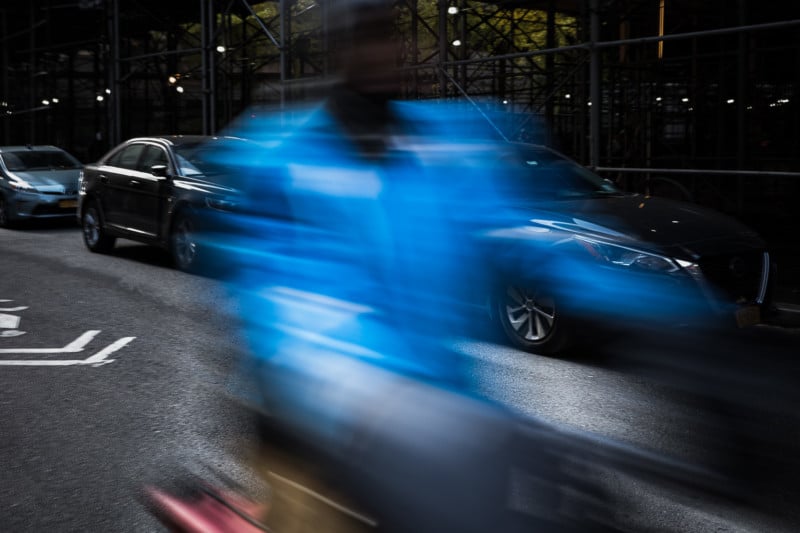
The 60.3MP sensor will actually check photographers’ capturing methods, in addition to their lenses. The better the variety of pixels per diploma of FOV — no matter sensor measurement or pixel pitch — will amplify the detrimental results of each sloppy method and uncorrected lens aberrations. What could have regarded nice on the 24MP Leica M10 could now be stuffed with aberrations and blurred pixels in case your shutter speeds aren’t ample. Have in mind, aside from some Hasselblad and Part One cameras, this sensor is extra taxing than another available on the market, alongside the Sigma fp L — the IBIS within the Fujifilm GFX 100 and 100S mitigate the difficulty.
I discovered 1/2x focal size to be the absolute minimal for pixel-level sharp outcomes, with 1/3x being optimum. This implies even with a 35mm lens, you’re ideally at 1/100 to 1/125. Fortunately, Leica has glorious minimal auto-shutter pace choices within the menu — simply be sure you set your lens data when you’re utilizing an older, non-coded lens.

Lastly, a fast touch upon out-of-camera JPEGs: I didn’t totally check this as a result of it appeared like one of many least essential issues to spend time on (particularly with a pre-production digicam with out remaining firmware), however I did do some fast, preliminary changes and testing with a number of of the JPEG modes till I obtained one thing I used to be moderately pleased with. And the outcomes are glorious — improbable shade, excellent element, and compression are minimal, which helps keep away from posterization and different artifacts. Whereas there may be clearly noise discount within the JPEGs, as with all different digicam, Leica has performed a beautiful job guaranteeing it doesn’t compromise tremendous particulars or yield waxy, smeary outcomes. Extra thorough investigation on this can be within the remaining evaluate.
Under are a set of pattern pictures that I captued as a part of my time with the M11.
![]()
![]()
![]()
![]()
![]()
![]()
![]()
![]()
![]()
Leica FOTOS 3.0
I didn’t get a lot time to make use of the brand new Leica FOTOS app, which was a beta model and nonetheless had many options to be added (the corporate estimates that can come within the second half of 2022) and kinks to work out, however I can say the time I did spend with it was simply essentially the most nice and easy wi-fi tethering expertise I’ve ever encountered. I solely used the app on my iPhone 13 Professional, however I may even check it with my iPad Air 4 as soon as I obtain the manufacturing unit.
Capturing with the FOTOS app — presently obtainable for iOS solely, as Leica stated most of its consumer base are iPhone customers — and altering settings couldn’t be easier. There’s little or no lag with each the live-view picture and making changes to settings, the connection by no means dropped and, not like each different app I’ve used except for Hasselblad, the preliminary connection setup could be very fast, easy, and intuitive.
Replace #1, 1/13/21: Whereas Leica knowledgeable PetaPixel that it was solely focusing on iOS, that doesn’t look like the case. We’ve reached out to Leica for readability, however the app is available on Google Play with famous help for the M11.
Replace #2, 1/13/21: Leica confirmed that regardless of the FOTOS app seeing an replace on the Google Play Store with famous help for the M11, it is not going to “for the time being” help the options touted within the model 3.0 replace. Meaning it may possibly’t be used to replace the digicam, picture search with filters, enable for multi-select of photographs, favoriting, or score. The Leica Fotos 3.0 app is a “Made for iPhone” product, and Leica didn’t present an estimation of if or when these options would come to Android.
The upshot right here is you not solely get nice options like embedded location knowledge, picture entry through Bluetooth, and elevated switch charges, however extra importantly, it makes the digicam a lot extra usable for tripod-based work outside or in a studio, particularly because it lacks a tilting LCD. In actual fact, the FOTOS app is so good and easy that I’d most likely use it over a tilting display screen in tripod-based conditions.
The Leica M11 Might Truly Be a Major Digicam

Leica has thrown every thing however the kitchen sink into the M11. In-body picture stabilization (IBIS) is the one main function I want had been included, however I believe there are vital limits to what could be stuffed right into a physique of this measurement (perhaps because of this Leica solely has a single SD card slot and inner storage and never two card slots). Maybe there are additionally limitations of the M mount throat, which is even narrower than the Sony E mount. Leica went to vital effort to lower the thickness of the M10 to match the movie M our bodies and IBIS would little question require them to backtrack on this regard. Nonetheless, if Ricoh can stuff three-axis IBIS within the Ricoh GR III and GR IIIx, I believe Leica is as much as the problem, even when it isn’t full five-axis.
The mix of all the weather right here — the high-resolution sensor with glorious dynamic vary and low-light capability, decrease decision pixel-binning choices, a silent digital shutter, the extremely spectacular battery life, 64GB of inner storage as an efficient second card slot (however with different advantages too), off-the-sensor metering, a brand new high-resolution tilting OLED EVF, the easy wi-fi tethering — makes the Leica M11 essentially the most full and versatile M digital thus far by a large margin. It nearly feels just like the leap from the M9 to the M240, as if a era has been skipped.
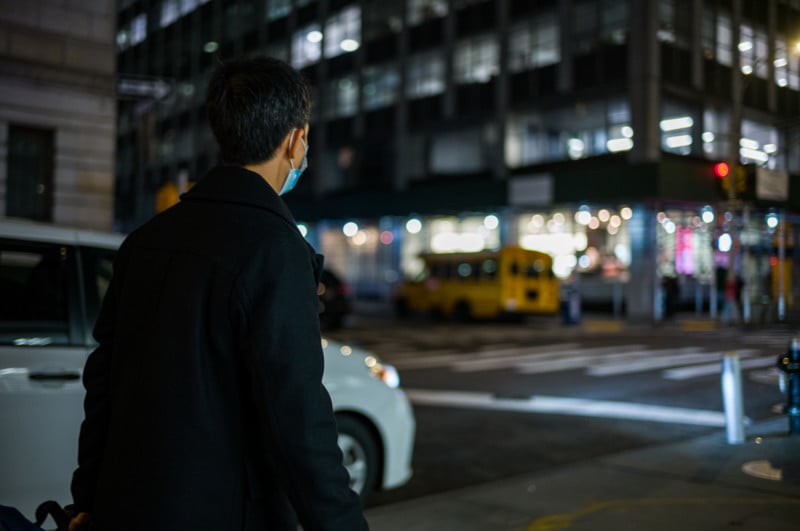
Maybe the very best reward I can provide the digicam, primarily based on my expertise to this point, is it’s the primary time I really feel like an M digicam may function my major system. No, it isn’t appropriate for a few of my work, nor may it’s my solely system, however the M11 is crammed with all of the capabilities I want for a great deal of my work, all with none vital shortcomings.
I’ve by no means thought of a Leica M digital digicam as a result of they’re far out of attain financially for me, but additionally as a result of there have all the time been sufficient vital limitations to the cameras that might forestall them from ever being greater than a enjoyable private digicam, reasonably than additionally a instrument for work. I now not really feel that’s the case with the M11.
Boy, do I want I had a spare $9,000. Perhaps a brand new M-E primarily based on the M11, Leica?